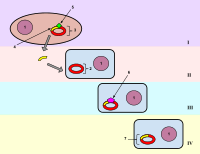
Genetic Transformation of Fusobacterium nucleatum.
Sign Up to like & getrecommendations! Published in 2021 at "Methods in molecular biology"
DOI: 10.1007/978-1-0716-0939-2_5
Abstract: Fusobacterium nucleatum is a human periodontal pathogen that causes opportunistic infections. It has been implicated in preterm birth and has as a pathogen of colorectal cancer. However, it is a common member of the oral… read more here.
Keywords: genetic transformation; fusobacterium nucleatum; transformation fusobacterium; transformation ... See more keywords

Genetic transformation of legumes: an update.
Sign Up to like & getrecommendations! Published in 2021 at "Plant cell reports"
DOI: 10.1007/s00299-021-02749-7
Abstract: KEY MESSAGE This review summarizes the recent advances in legume genetic transformation and provides an insight into the critical factors that play a major role in the process. It also sheds light on some of… read more here.
Keywords: legumes update; improvement; genetic transformation; transformation ... See more keywords

Genetic transformation of Chlorella vulgaris mediated by HIV-TAT peptide
Sign Up to like & getrecommendations! Published in 2019 at "3 Biotech"
DOI: 10.1007/s13205-019-1671-2
Abstract: Scientific interest in microalgal species is growing and, genetic transformation has definitely opened more avenues, in the ongoing research on microphytes. In the present study, we have attempted to transform Chlorella vulgaris by mobilizing double-stranded… read more here.
Keywords: genetic transformation; chlorella vulgaris; vulgaris; transformation ... See more keywords

Biotechnology of oil palm: Current status of oil palm genetic transformation
Sign Up to like & getrecommendations! Published in 2018 at "Biocatalysis and agricultural biotechnology"
DOI: 10.1016/j.bcab.2018.07.008
Abstract: Abstract Oil palm is the most productive vegetable oil in the world for human consumptions and industrial applications. Increasing demands of palm oil over the years have led the research interests to improve yield and… read more here.
Keywords: palm genetic; genetic transformation; oil; oil palm ... See more keywords

Establishment of efficient callus genetic transformation system for Pyrus armeniacaefolia
Sign Up to like & getrecommendations! Published in 2021 at "Scientia Horticulturae"
DOI: 10.1016/j.scienta.2021.110429
Abstract: Abstract The purpose of the present study was to establish an efficient and stable callus genetic transformation system for Pyrus armeniacaefolia. Fruits 15 days after flowering were used for callus inducing. Major factors that influence… read more here.
Keywords: genetic transformation; system pyrus; transformation system; callus genetic ... See more keywords

Genetic transformation of indica rice varieties involving Am-SOD gene for improved abiotic stress tolerance
Sign Up to like & getrecommendations! Published in 2019 at "Saudi Journal of Biological Sciences"
DOI: 10.1016/j.sjbs.2017.06.009
Abstract: Agrobacterium mediated genetic transformation has become an important tool in crops for molecular breeding. Am-SOD quality containing transgenic plants were created from embryogenic calli of Sambha mahsuri and cotton sannalu by Agrobacterium tumifaciens co-development. The… read more here.
Keywords: genetic transformation; indica rice; rice varieties; transformation ... See more keywords

Improving genetic transformation rates in honeybees
Sign Up to like & getrecommendations! Published in 2018 at "Scientific Reports"
DOI: 10.1038/s41598-018-34724-w
Abstract: Functional genetic studies in honeybees have been limited by transformation tools that lead to a high rate of transposon integration into the germline of the queens. A high transformation rate is required to reduce screening… read more here.
Keywords: genetic transformation; transformation rate; transformation rates; transformation ... See more keywords

Development of a genetic transformation toolkit for Brettanomyces bruxellensis
Sign Up to like & getrecommendations! Published in 2018 at "FEMS Yeast Research"
DOI: 10.1093/femsyr/foy070
Abstract: &NA; Brettanomyces bruxellensis is usually considered a spoilage microorganism, responsible for significant economic losses during the production of fermented beverages such as wine, beer and cider, though for some styles of beer its influence is… read more here.
Keywords: genetic transformation; bruxellensis; transformation toolkit; brettanomyces bruxellensis ... See more keywords

Characterization and genetic transformation of an Ehrlichia isolated from a Minnesota tick.
Sign Up to like & getrecommendations! Published in 2019 at "Applied and environmental microbiology"
DOI: 10.1128/aem.00866-19
Abstract: Ehrlichia muris subsp. eauclairensis is recognized as the etiological agent of human ehrlichiosis in Minnesota and Wisconsin. We describe the culture isolation of this organism from a field-collected tick and detail its relationship to other… read more here.
Keywords: transformation ehrlichia; isolate; genetic transformation; ehrlichia ... See more keywords

An Efficient Agrobacterium-Mediated Genetic Transformation Using Embryonic Axis in Cotton (Gossypium hirsutum L.)
Sign Up to like & getrecommendations! Published in 2020 at "Russian Journal of Plant Physiology"
DOI: 10.1134/s1021443720030024
Abstract: Abstract Agrobacterium- mediated genetic transformation approach allows for introducing novel genes in cotton ( Gossypium hirsutum L.). Development of efficient regeneration and transformation protocol is very important for recalcitrant plants like cotton. In the present… read more here.
Keywords: genetic transformation; cotton; mediated genetic; agrobacterium mediated ... See more keywords

Genetic transformation of einkorn (Triticum monococcum L. ssp. monococcum L.), a diploid cultivated wheat species
Sign Up to like & getrecommendations! Published in 2018 at "BMC Biotechnology"
DOI: 10.1186/s12896-018-0477-3
Abstract: BackgroundDomesticated einkorn (Triticum monococcum L.) is one of the oldest cultivated cereal crops in the world. Its small genome size (~ 5.7 GB), low ploidy (2n = 2x = 14, AmAm) and high genetic polymorphism make this species very attractive for… read more here.
Keywords: genetic transformation; einkorn triticum; transformation; monococcum ... See more keywords